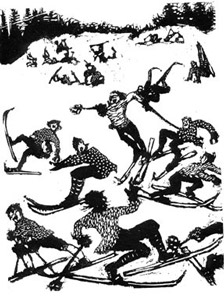The 1920s: Daring Shape of Things to Come
Authored by Morten Lund
The 1920s saw a rift open between the upstart idea of skiing for the sake of the descent, or alpine skiing, and traditional nordic skiing in which the ascent, distance traversed, or distance jumped was the important thing.
Alpine skiing would soon dominate, particularly in German-speaking countries. The revolutionaries struggling with alpine skiing are documented in the 1922 Das Skibuch, which pronounces it a mad medley of mayhem and ignorance. Alpine technique itself was in flux from the single-pole approach of Mathias Zdarsky shown in some cartoons to two-pole technique shown in others.
The awful result was wonderfully memorialized for English readers by A.H. d’Egville, a leading spirit of alpine skiing, as well as a noted alpine racer and inspired cartoonist. His S’no Fun, published in 1925, shown on the next page, underlines the function of cartoons as graphic records showing the true dimensions of the struggle to master the sport back in the 1920s. Without cartoons, it would never have been clear, for instance, as d’Egville shows, that an unfailing sign of the skier was a set of bruised hindquarters.
Cartoonists were quick to latch on to an important element ignored elsewhere. This was the Roaring Twenties, after all, and fetching young things were quite naturally drawn to the early ski resorts. A quite remarkably clad, or unclad, young lady on a 1927 cover of Le Sourire works as a metaphor for an early form of extreme skiing, risking crashing in a passionate downhill chase d’amour. Real nordic skiers did not indulge in obvious onsite hanky-panky. But the short climbs and leisurely descents typical of fashionable alpine ski clientele at resorts left plenty of energy for apres-ski. In fact, the ski resort building accelerated after alpine skiing took hold, and that is not surprising. Easier skisport bred more sumptuous apres-ski. This in turn helped propel the popularity of alpine skiing.
Another factor was the surge of alpine competition, which lent glamor to the sport. The father of the modern downhill was the Roberts of Kandahar run by British racers on the glacier at Montana, Switzerland in 1911. Ten years later, in 1921, the first persuasive slalom format had been set just outside the Palace Hotel at Mürren by Arnold Lunn. And, in 1928, the first open alpine combined ski race, the Arlberg-Kandahar, was held at St. Anton, run by Britain’s Kandahar Ski Club and St. Anton’s Arlberg Ski Club.
The outlines of alpine skiing for the next fifty years had been pretty much settled. There would be ski races, ski resorts, apres-ski, ski schools, and ski instructors. All this became clear during the flowering of alpine skiing in the 1930s. -- Morten Lund

